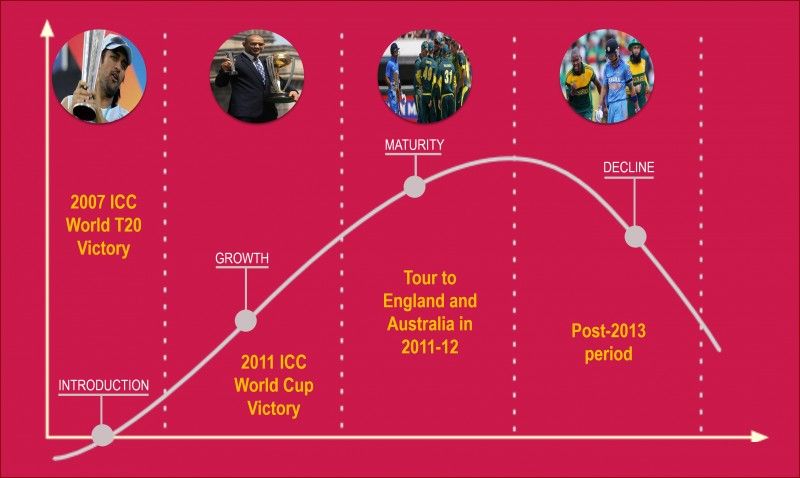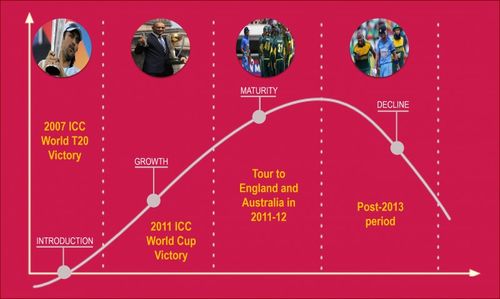
MS Dhoni and the Product Life Cycle
Probably every marketing (or non-marketing) student is au fait with the concept of Product Life Cycle (PLC) in marketing. Like human beings, products are born, followed by which eventually reach their peak (in terms of capturing market share or consumer loyalty) and finally phase out from the market sphere.
Having closely followed MS Dhoni’s (MSD) game for a long time, his career reminds me of a simple traditional PLC.
As a disclaimer, I would like my readers to note that I am not a so-called ‘MSD hater’, and my views are simply reflective of my opinions. Like I mentioned, MSD’s career reminds me of the PLC.
Stage 1: Introduction Stage
I remember when MSD began his phase as the captain of the Indian squad for the inaugural ICC World Twenty20 held in South Africa in September 2007. The outcome of the tournament was, as we all know, legendary!
His captaincy on a stand-in basis against South Africa and Australia in 2008 and 2009 respectively was met with moderate success as well. In 2008, he captained the last game of the Border-Gavaskar Trophy in 2008 and they retained the trophy that year. This was the time when Dhoni began to be labelled as a ‘brand’.
Stage 2: Growth Stage
In the growth phase, the organisation seeks to enhance brand preference and escalate market share. Similarly, this was the time MSD began to develop as a captain. He became popular as ‘Captain Cool’ in light of his tranquil demeanour displayed in handling his players.
He started winning games abroad as well, as marked by successes in Australia as well as New Zealand. Like a product which keeps on augmenting its features and additional support services, MSD’s innovative captaincy started catching the eyes of many critics and India reached No. 1 spot in tests, ODIs and for a while in T20s as well.
The peak of his career happened with the ICC Cricket World Cup 2011. Cricketing greats hailed him as one of India’s greatest captains. This was accelerated due to his perennial success in the IPL year after year.
Stage 3: Maturity Stage
At the maturity stage, the rapid escalation in product sales is on the wane. The prime object is to defend market share while maximising profit in an otherwise saturated market. The England tour post the 2011 World Cup marked the beginning of the maturity stage for MSD.
His strategies and experimental tactics were backfiring and a lot of new strategies were undertaken to analyse what was going wrong. The tour to Australia similarly ended on a stale note.
The home turf was the only place which was rewarding Dhoni, as India managed to whitewash Australia in the 2013 Border-Gavaskar Trophy. There were plenty of ups and downs, especially in the Test arena.
Stage 4: Decline Stage
This stage is simple: sales decline! I would say the decline phase happened due to MSD’s prolonged failure in Test matches. Success in ODIs were oscillating frequently and the percentage of wins started declining slowly across all formats.
During this stage, companies must divest their assets to ensure survival. MSD too, retired from Test cricket to focus more on ODIs and T20s. However, success is rather drained at the moment.
All successful captains go through a similar phase. Sourav Ganguly went through a similar phase and rightly gave up captaincy to focus on his game. Every effective captain brings about some avant-garde ideas as they take up captaincy. Soon enough, they reach a peak, followed by which their ideas and tactics get saturated.
They must hence make way for a fresh up-and-coming captain, who would definitely bring about some novelty, be it change in perspective, motivation or squad-based alterations.That's how the game of cricket advances and becomes as innovative as AB de Villiers.
Do heed, yet again that this article is not written as another commentary against MSD’s captaincy, but is penned strictly from a marketing perspective. Don’t forget, MSD has won India all major international trophies. I can’t recall another captain who has achieved this feat. Like every product, captaincy also has a life cycle.
